This Oil Rig is in a Sanctuary. Is it Better Removed or Made into a Reef?
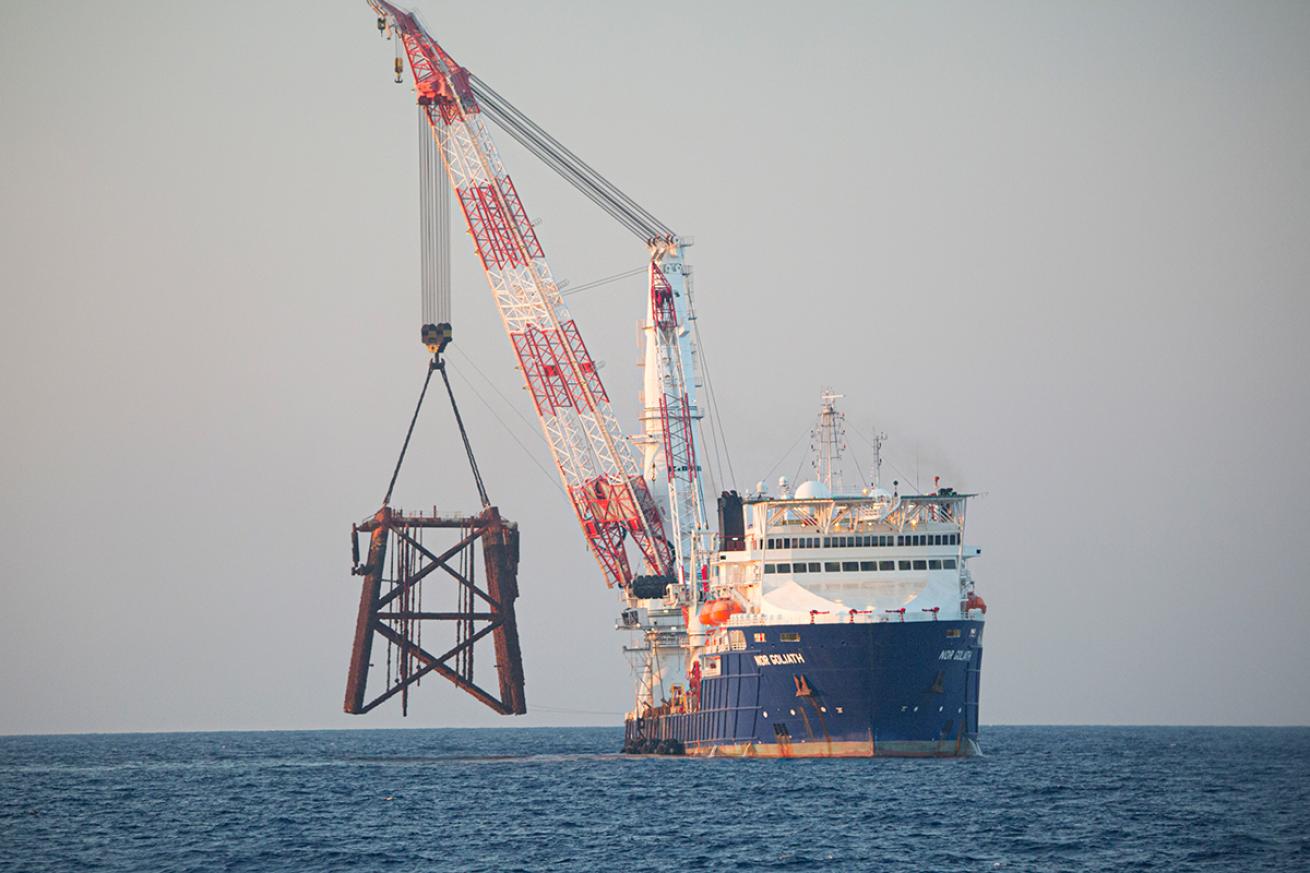
NOAA/G.P.SchmahlPart of High Island 389A dangles above the water.
From the moment the end was in sight, the odds were stacked against High Island 389A.
In 2012, oil and gas company W&T Offshore Inc. readied to stop operating one of its moneymakers in the Gulf of Mexico: a natural gas platform 100 miles south of Galveston, Texas, known as HI389A.
This eight-legged platform had been in faithful service since October 1981, installed by Mobile Oil. Well-maintained gray paint kept its bones looking professional, but the thick rust climbing the deck legs showed its age.
If it had been solely up to the offshore drilling teams, it would have been a simple call: Cut bait. Remove every last railing, support and bit of metal involved.
But HI389A enjoyed a double life.
Below the waterline, it offered 410 vertical feet of life-covered structure that recreational divers prized for unforgettable experiences.
To its benthic community of tunicates, stony corals and zoanthids, it was home. It also stood as a magical outpost, mysteriously attracting mantas and scalloped hammerhead schools—animals that otherwise don’t typically travel in these waters. For all this life and wonder, the rig’s cult following grew stronger each year, right alongside its orange Tubastraea coral colonies.
So when news spread that HI389A was facing decommission, a few vocal folks had something to say.
That’s when the fight began.
One and Only
There’s another thing to know about High Island 389A: It’s the only oil rig within a National Oceanic and Atmospheric Administration sanctuary.
Credit timing. HI389A predates Flower Garden Banks National Marine Sanctuary by nearly a decade. This underwater park, best known for coral banks rising within yards of the surface, didn’t find protected status until 1992, 11 years after HI389A began service.
Nonetheless, the handlers of HI389A answer to sanctuary rules. At first, it was a relationship as cooperative as eels and grouper hunting in tandem: Platform workers contacted sanctuary officials whenever they spotted illegal fishing vessels and other activity that warranted correction.
This happy friendship made what came next more than slightly complicated.
Decommissioning requires the operating oil company to choose which of three options best suits the platform. One, it can be removed completely—the least-fun option for divers, but the easiest and cheapest solution for the oil company. No platform, no problem.
Two, it can be partially removed, which means dismantling the structure above the waterline while preserving everything below.
The third option—and the most expensive by far—entails keeping the entire structure in place, save for the equipment necessary for fuel extraction. Repurposed, the structure could live anew as a research station or a wind turbine. To move forward with this scenario, one question demanded answering: If the two levels spanning 60 feet above the surface remained, who would monitor and maintain them? Although certainly the most intriguing possibility, this also proved the most unlikely.
Photographer Jesse Cancelmo, a member of the Flower Garden Banks National Marine Sanctuary Advisory Council and a diver who has been visiting the platform since it was first installed, helped push to explore ways to make this work.
In the end, he says, “Unless we had a very deep-pocketed person come in and say, ‘I will own it and take care of it and all the liability,’ it just didn’t make sense.”
That left two options, with divers such as Cancelmo rallying for the option that would save their beloved underwater structure.
“I’ve been emotionally attached to the platform since I first dived it,” says Cancelmo.
He’s not alone. “This particular platform has been recognized as the best in the northwest Gulf—some people like diving on it more than the natural reef,” he says.
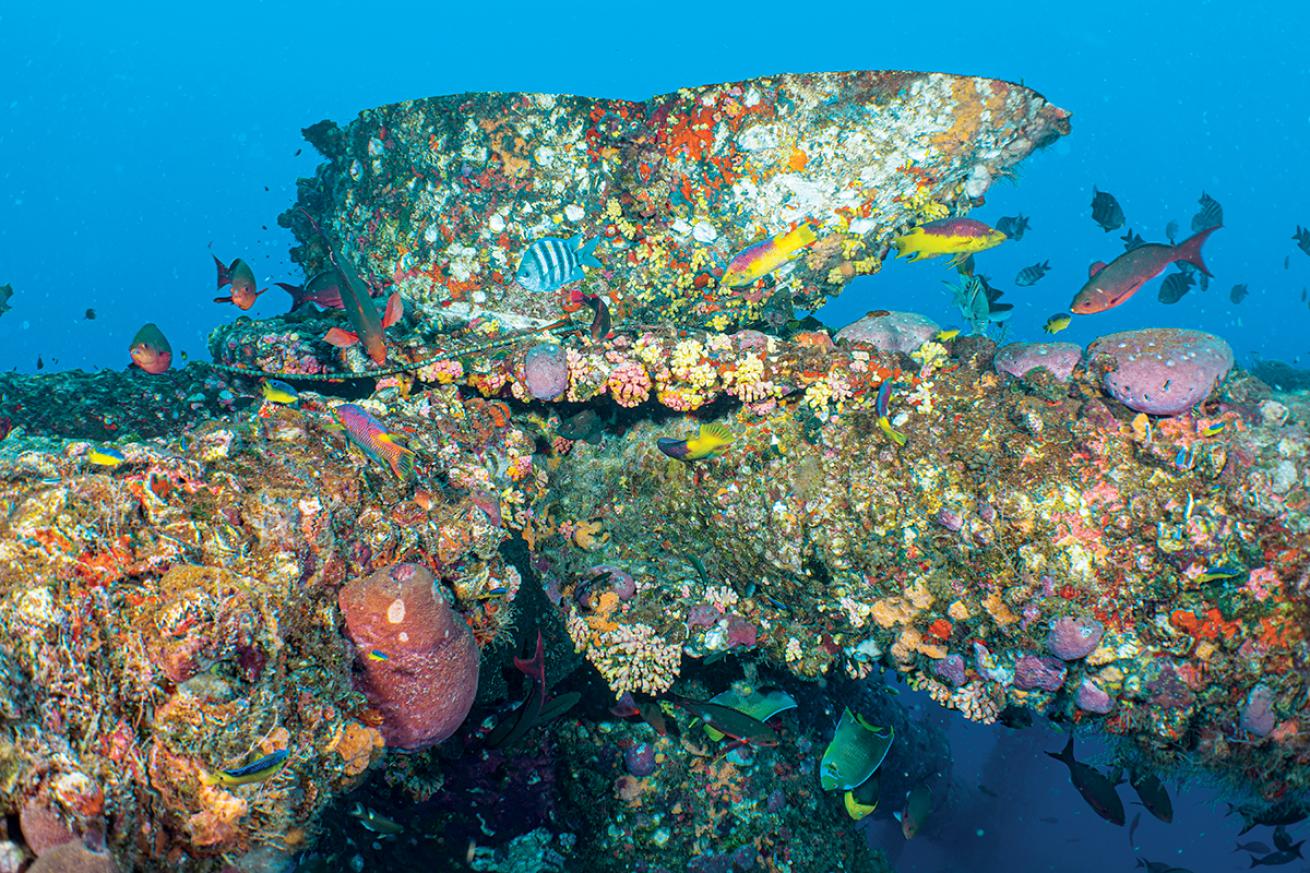
NOAA/G.P.SchmahlRiotous life in an underwater oasis shows why divers love decommissioned oil platforms, and biologists don’t. Much of this life is non-native and outcompetes endemic species.
The rig is what’s called a fouling community, defined by species that thrive when clinging to artificial structures.
“You see sponges and bivalves—these are not the typical things you see on the coral reef, although there is certainly overlap in the fish species,” says Emma Hickerson, research coordinator for the sanctuary. “It looks different from a coral reef community, and, ecologically, is not providing the same things that a coral reef does.”
Different, but no less complex.
“This is not a narrow ecosystem by a long shot,” says Cancelmo of the range of life—from macro critters to pelagic wonders—that populates the site. “Tessellated blennies an inch long hide in little barnacle shells, and on the opposite end you get silky sharks and whale sharks.” In the midrange of sizes, the platform also supports butterflyfish, brown chromis, angelfish and a host of other tropical fish.
The list of life alone would likely have any diver leaning toward protecting the structure. After all, why would anyone be in favor of making a blenny homeless?
Still, Cancelmo has heard plenty of arguments against.
He rattles off the sanctuary staff’s typical reasons: “These things are eyesores. They are man-made and don’t belong in the natural environment. They will all tumble down eventually.”
“Why are they here?”
While such structures are designed to weather the impact from a natural disaster, it wouldn’t be impossible for a hurricane to knock one loose from its base, sending it crashing onto natural reef.
Storms aside, there’s another reason Hickerson worries about a man-made hazard such as HI389A. “Ecologically, it is preferable to have it removed in total. Artificial structures can change the environment.”
For starters, HI389A and its peers provide structure for invasive species to colonize.
Consider the Tubastraea, aka orange cup coral.
Says Hickerson: “High Island 389A is dominated by orange cup coral. From a diver’s perspective, it’s beautiful. But that coral doesn’t belong. It’s endemic to the Indo-Pacific.”
This pop of cheery color is one of the reasons divers love the structure—and yet, it also endangers the Flower Gardens. Like any other nonendemic species, this coral can cause unpredictable damage to the natural ecosystem, potentially overtaking more delicate species. Nonendemics like the Tubastraea, in the absence of oil platforms, would likely never come close to the Flower Gardens. HI389A and other rigs change that. These structures, scattered throughout the Gulf, allow invasives—including lionfish—to ping-pong their way to protected coral reefs. Without these man-made structures, the trek to the natural reef would be too great.
Says Cancelmo, “Out in the northwest Gulf, a number of banks exist, but in between them, there isn’t a whole lot.”
For divers, it’s a treat to have the platforms, adding to the roster of available dive sites.
But the reef species might have something else to say.
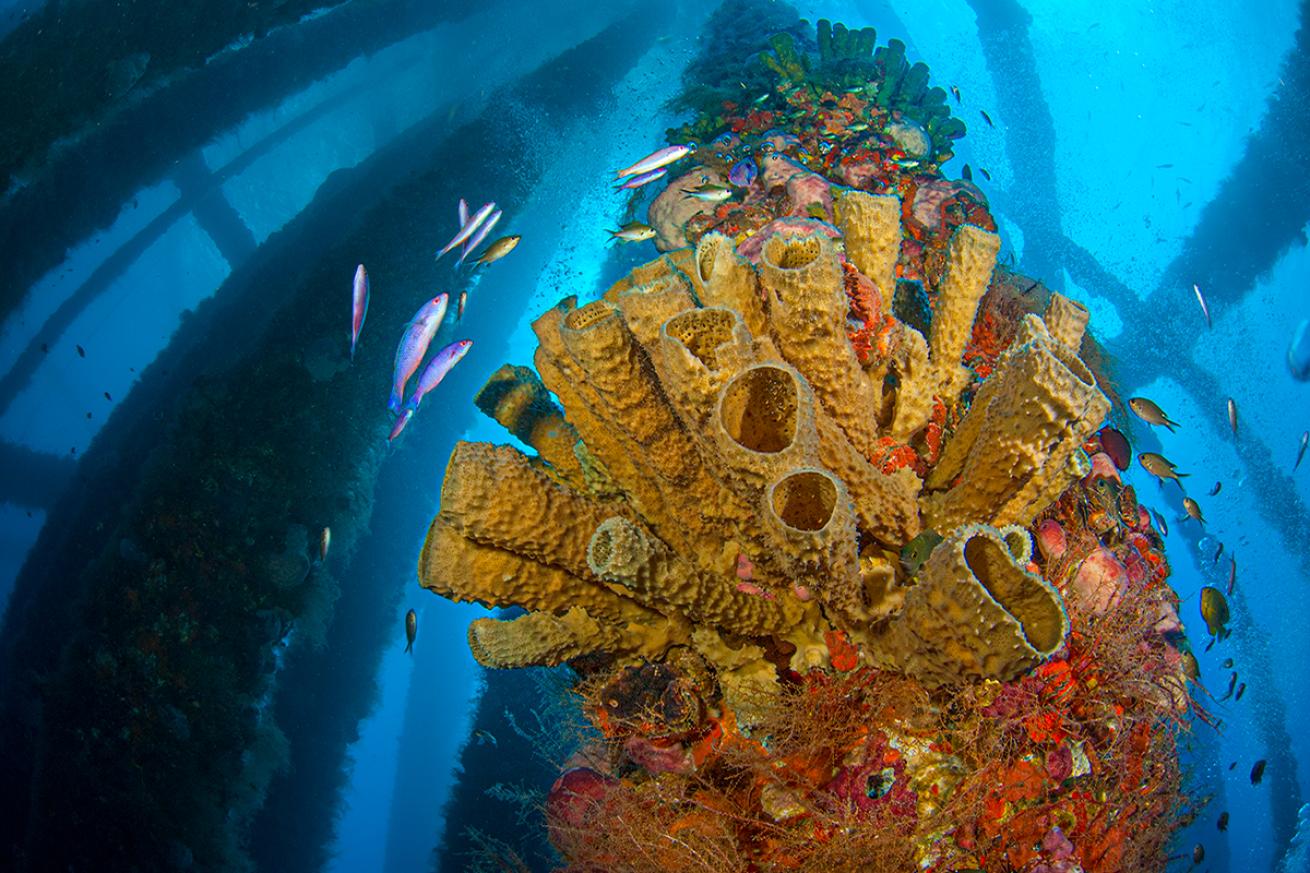
NOAA/G.P.SchmahlA a colorful range of sponges, tunicates and coral call the structure home.
These artificial structures create shallow habitat where there otherwise was none, providing an opportunity for sergeant majors to colonize,” says Hickerson.
That shallow habitat resulted in what is called a range extension for the black-striped species. They naturally occur in the Caribbean, not in the Gulf—until the platforms entered the picture.
Acting like stepping stones, oil platforms have also allowed a new species, the regal damselfish, to take hold in the area.
“We don’t know yet what their full impact is,” says Hickerson.
HI389A was a particular thorn in the side for Flower Garden Banks researchers as it was installed less than a mile away—right next to one of the healthiest coral reefs in the entire Gulf, home to very high coral cover and very large corals.
Although opposed to the structure’s impact, Hickerson isn’t immune to its charms—including the schools of scalloped hammerheads that frequently swim past.
“They showed up when I wasn’t expecting,” she says of a school of 30 encountered during a research dive.
The species is present with such regularity that she started questioning whether they have established some degree of residency—atypical, given that they aren’t known to be present in this area. “Anytime I see sharks, I am excited—but the scientific side of my brain is thinking, Why are they here? This is odd,” she says.
The Magic Number
As mesmerizing as hammerheads might be, they weren’t reason enough for Hickerson and her peers to favor keeping the platform after its gas career ended.
“The sanctuary staff wanted to have this thing removed as soon as production finished,” says Dale Shively, member of an artificial reefs group that is part of the Texas Parks and Wildlife Department.
At the same time, the advisory council for the Flower Garden Banks National Marine Sanctuary was rallying, with Cancelmo taking an active lead.
The advisory council represents the interests of commercial fishing, recreational fishing, recreational scuba diving, oil and gas communities, and others with vested interests in the resources of the sanctuary.
Within the advisory council, 15 people, including Cancelmo, formed the Artificial Reef Working Group to put together an official recommendation to the sanctuary. From there, everything would have to fall in place like dominos to affect the desired outcome.
“The work group makes a recommendation to the council, the council makes a recommendation to the sanctuary manager, and the sanctuary manager would go to W&T Offshore Inc. with a recommendation,” explains Cancelmo.
A year unfurled before a consensus was reached. The final recommendation, at 76 pages long, was the work of engineers and marine biologists. It considered the interests of those who would use the platform, if kept, as well as the impact on 75 fish species and other marine life. The report detailed the impact of complete removal, which would “be equated with total loss of artificial reef habitat and associated organisms at the existing platform location.”
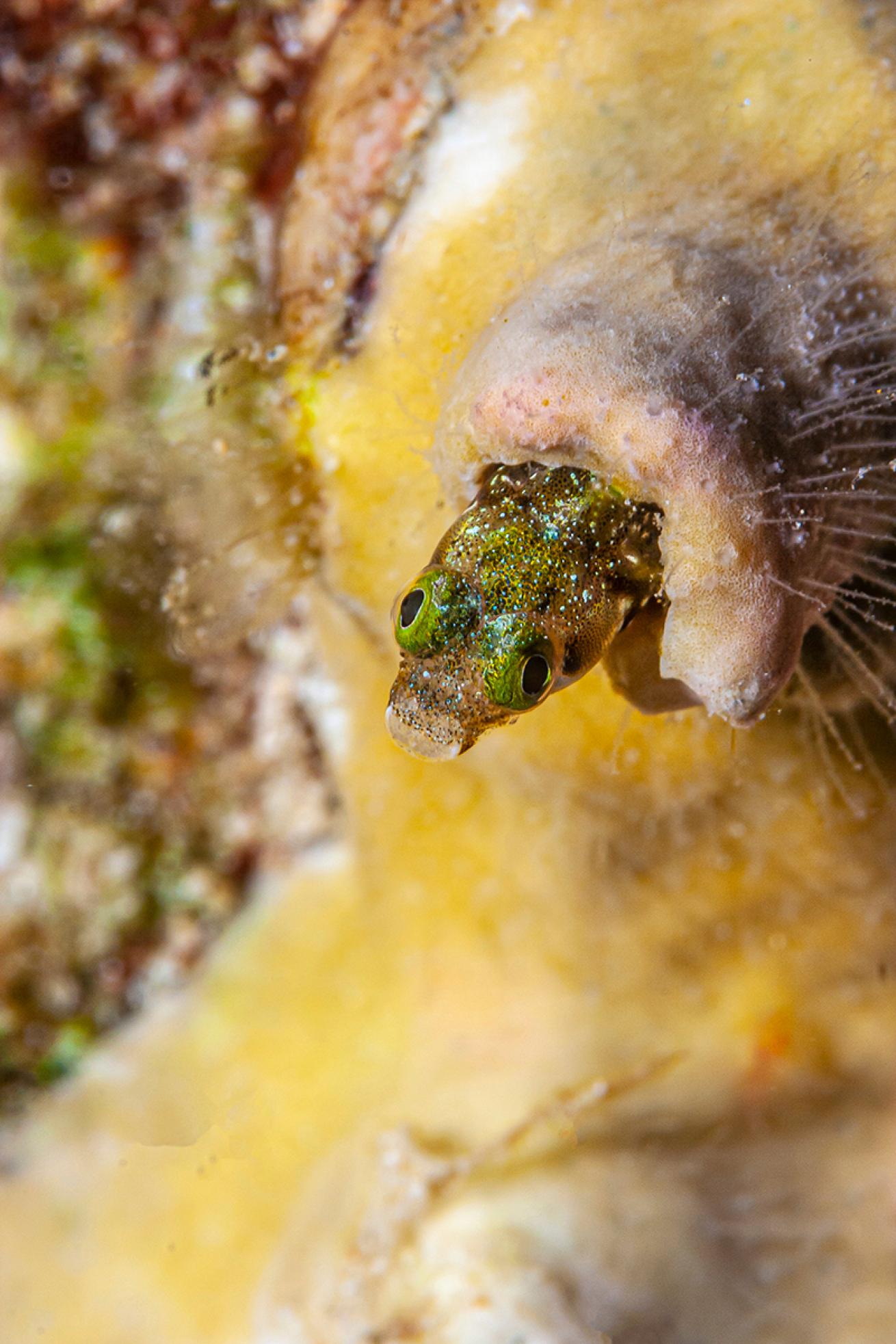
Shutterstock/John A. AndersonA blenny rests on the rig.
At the report’s recommendation of removal at 40 feet, the “percentage of species that lose their habitat entirely shrinks to just 10 percent.”
Forty feet was the magic number they settled on and presented in the May 2013 meeting, electing to save the structure below that line all the way to 410 feet. This plan required no maintenance. “With this, we thought there would be no worries—a minimal risk of it falling down, and with nothing sticking out of the water, there’s no risk of a hurricane coming and causing damage,” says Cancelmo.
But by the time the recommendation traveled from the hands of the work group all the way to W&T, the oil company was already months—and countless dollars—into the permitting process for a full removal.
Even Cancelmo wouldn’t have wagered on his team’s odds.
“We went into those offices figuring we maybe had a 50-50 chance of them accepting it,” he says of the July 2014 meeting.
And yet, the company changed its mind and decided to accept the recommendation for partial removal, despite the fact that it would cut into profits to restart the process.
“I was ecstatic,” says Cancelmo.
And so on July 25, 2018, HI389A became what it is today: a structure only visible to fish, pelagic marine life and the divers who come to witness it all. Responsibility for maintenance moved to Shively and his crew with the Texas rigs-to-reefs program; a patch of ocean bottom around the area where the legs are anchored is now owned by that state government.
For Cancelmo, it was a clear victory. “These platforms are havens for marine life. They are protective devices where marine life can hide from predators.”
For Hickerson, the results are not so easy to sum up—at least, not yet.
“There has only been roughly a year between the removal and the first study,” she says. “When we go back in five years and conduct another post-removal study, that will be a better assessment of whether or not this choice was the right one for the environment.”
Getting There
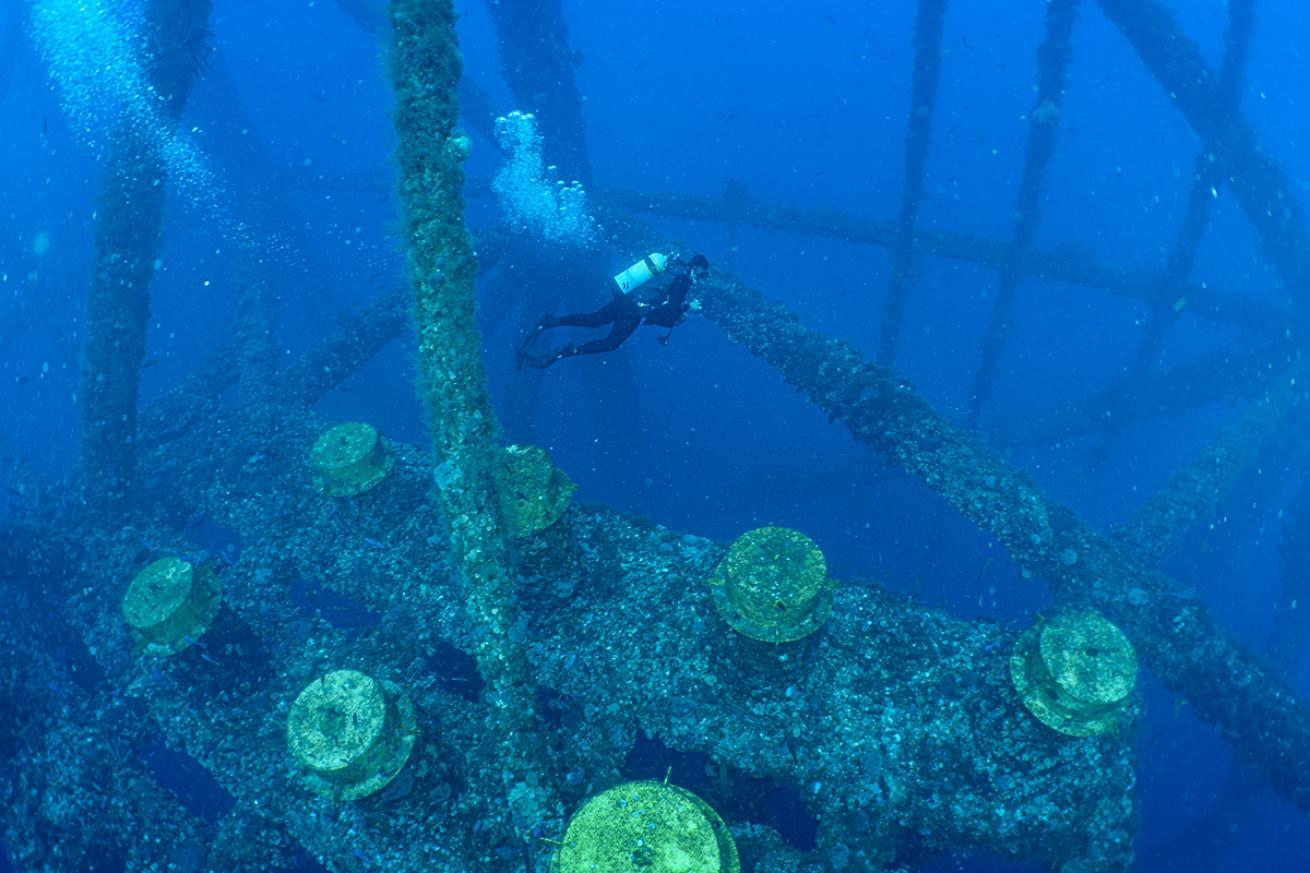
NOAA/G.P.SchmahlA diver fins through the middle of the High Island 389A,.
Private boats can make the trip to HI389A, marked by a buoy maintained by Texas Parks and Wildlife. Alternately, book with Happy Hooker Charters, based in Sabine Pass, Texas. The trip out is weather dependent, so don’t count on going on a specific day; instead, allow yourself a window of at least four days. Owner Capt. Josh Davis recommends being flexible with dates. “If you book a month out, you’re gambling on that day,” he says. “You need the seas to be almost perfect.” He books his vessel as a private charter, available at a flat rate of $2,200 plus fuel costs for a day.
Agent Orange
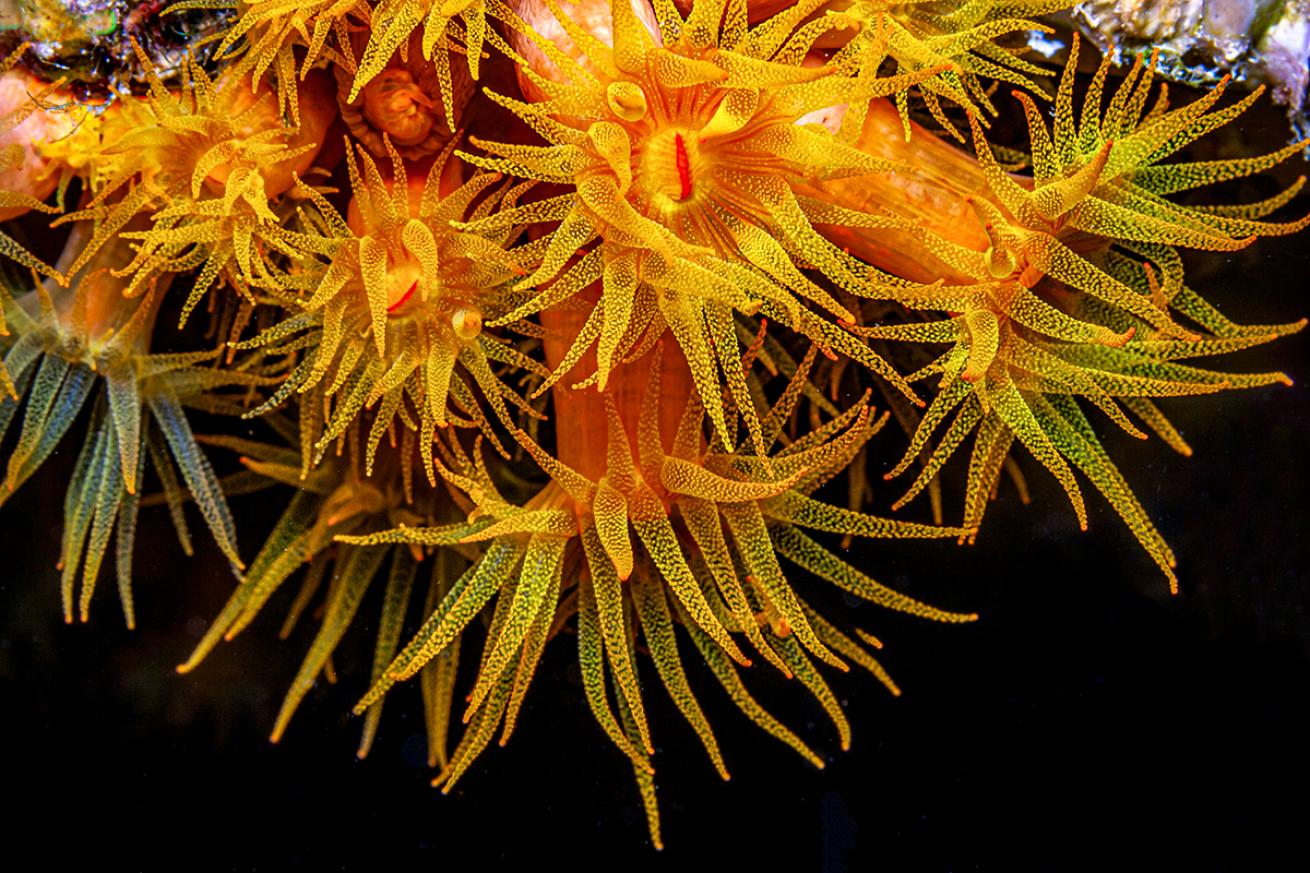
Shutterstock.com/John A. AndersonOrange cup coral is native to the Indo-Pacific, not the Caribbean.
Orange cup coral is everything divers love about marine life: bright, exotic, coral. But exotic in this case means something grim.
Most divers don’t realize that this species—Tubastraea—is not native to the Gulf. It’s non-native to the entire Caribbean, in fact. It hails from the Indo-Pacific regions, first showing up in Puerto Rico and Curaçao in 1943. As with lionfish, it is believed that oil tankers transited the coral, either as a hitchhiker or in ballast water. From these destinations, it spread. Quickly. One reason the cup coral does so well on oil platforms is that, unlike other coral species, it doesn’t sup- port or need symbiotic algae. In other words, it doesn’t require photosynthesis—or sun—to grow. Thus it can multiply endlessly in darker environs, such as dock pilings or the legs of gas platforms.
Capable of growing quickly, orange cup coral is, in fact, any- thing but rare in the Gulf. This invasive species has all but taken over. On a single platform there can be hundreds of thousands of orange cup coral colonies. Then consider that the Gulf is home to 2,000 to 3,000 such platforms, 100 within 25 miles of the sanctuary.
Says Flower Garden Banks research coordinator Emma Hickerson, “It is choking out other life. We do know it is taking up available space on natural habitat as well.”
Hickerson understands why divers enjoy the platforms, but from a biologist’s perspective, they shift the landscape irreversibly.
“If that platform were never there, would that coral have made it to the banks?” she asks.
Today, orange cup coral dominates all three of the Flower Garden Banks. If any one species overwhelms an environment, natural diversity isn’t possible. As it stands, the two biggest threats to the Flower Gardens are lionfish and orange cup coral. Both are pretty, but, as it turns out, are wreaking consequences that are anything but.










